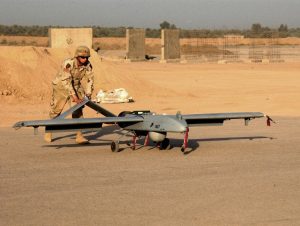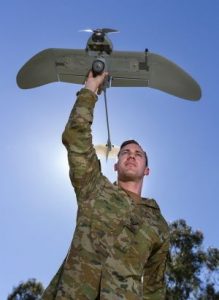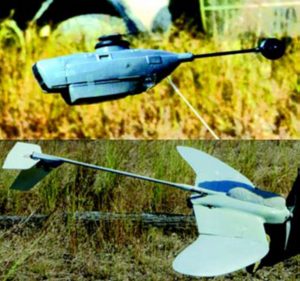Introduction
All four drones take off simultaneously, speeding towards their objective. They are small, agile and fast, moving at over 100km/hr on the way to their target. The operators are young and relatively inexperienced, drawn to their current mission by videos they had watched online, their devices thrown together in dimly lit garages in preparation for this day. As the drones rapidly advance on their goal, the lead drone strikes it’s propeller on an obstruction in its path, sending it crashing to the ground. Nevertheless, three drones continue on and reach their final destination, all within four minutes of being launched. Mission accomplished.
The 2017 Australian Drone Nationals has just concluded its final race. This event in the Gold Coast hinterlands saw sixty civilian competitors and a four-person Australian Army team race their custom-made and off-the-shelf Unmanned Aerial Vehicles (UAV) through a series of obstacles in pursuit of the fastest time, followed by a free-style event later in the day to show off individual prowess with the controls and the First Person View (FPV) goggles that each uses to traverse the course. The winner: an 18-year old with a mere six months experience.
There are numerous observations that can be made and conclusions drawn as to the significance of this event, from how readily accessible UAV technology is, to how easy they are to use and to the potential military applications. This article seeks to draw a number of similar conclusions but to also invite further discussion on the topic.
Questions to consider
UAV technology is far from a new concept as anyone watching the news over the last decade has seen. The US has drawn both admiration and condemnation for their use of UAVs in declared conflict zones, non-declared conflict zones and in their own homeland. The Australian Defence Force (ADF) itself has used UAV technology to great effect in recent operations, through all three Services, and is continuing to procure more advanced systems in the near and far future.
Similarly, law enforcement agencies, other government and non-government agencies around the world have adopted similar systems in order to make their jobs easier, more effective and safer. Examples of this include the US Federal Bureau of Investigation (FBI) admitting to using UAVs for domestic “surveillance”[i] and increased demand for agricultural UAVs in Australia[ii].
This is not what this article is about. This article seeks to raise two simple questions:
- To what degree will small, off-the-shelf UAVs be involved in near-future warfare?
- What can the Australian Army do on the tactical level to combat these UAVs?
Many in the military community would be tracking the recent reports coming out of Iraq and Syria on the use of off-the-shelf or custom UAVs by the Islamic State (IS) for dropping grenades and mortars on Government forces[iii]. The attacks have been branded an 'act of desperation' by some military commanders and commentators[iv]; however, there can be no denying that UAVs used on a tactical level by soldiers, guerrillas, insurgents, disgruntled or radicalised citizens etc. will be a continuing and growing trend for the foreseeable future.
Why is this? They are cheap, easy to use and safe.

Look online and you’ll find dozens of different drones available for purchase at the click of a button and the swipe of a credit card. They are available in stores throughout most major countries, including Australia, or easily imported. For a few hundred dollars you can have a fleet of your own UAVs at your doorstop in 3-5 business days. Secondly, they are relatively easy to use and train with; take the Drone Nationals winner for example, a young, keen competitor born into a tech-savvy generation, much like many of the combatants seen in current conflicts. UAVs do not require extensive doctrine or a six-step learning process to be a deadly force multiplier. Most come with simple controls and FPV goggles to observe and acquire targets, and there are countless videos on YouTube on how to learn and then hone your flying skills.
Lastly, off-the-shelf and custom UAVs retain the key principle that modern militaries crave, and why they are pouring millions of dollars into UAV projects: protecting the pilot. UAVs provide a range that shields the pilot from counter-measures; based on the sophistication of the device this can be anywhere from half a kilometre to 1800 kilometres. This particular attribute has also been very favourable to: combatants in current operations as it allows them to preserve a dwindling fighting force.

US Army by Spc. James B. Smith Jr.
To what degree can we expect to see small UAVs in near-future warfare?
As already discussed, UAVs are already appearing more regularly in unconventional warfare in the Middle-East from both IS and Hezbollah[v]. But what about their application in conventional warfare? In a state vs state conflict we can expect similar tactics and techniques with small, manufactured platforms acquired by Defence projects, similar to the platforms being rolled out by the Australian Army this year[vi]. UAVs are assets that are best deployed to achieve tactical-level objectives and commanders will need to be innovative in their use. The platform will be used to achieve a variety of effects, both kinetic and non-kinetic: lethal, psychological, ISR, target acquisition, GPS-jamming etc. Examples of this can be seen from reports emerging from the Ukraine in the use of UAVs by Russian separatist forces and the opposing Armed Forced of Ukraine, where UAVs and UAV counter-measures are becoming key enablers[vii]. A prime example of this has been the use of drones by the Ukrainian Aerial Reconnaissance Unit to provide battlefield ISR for their artillery units[viii].
To pose a tentative conclusion to this first question; it can reasonably be assumed that the use of UAVs will be an upward trend for both conventional and unconventional warfare. Both state and non-state actors are currently employing this technology to a limited effect, and in warfare adaptability and improvements will continue to be a race to remain ahead of the game.

What can the current and the near-future Australian Army do about this growing threat at the tactical level?
As any basic research can tell you, like all evolutions in warfare, a counter-measure is always developed to defeat new threats systems, followed by another innovation, followed by another countermeasure etc. UAVs are no different, and counter-measures are already being tested, from high-end, solid-state laser capabilities, to platoon level 'drone rifles'[ix]. This issue comes with its own set of questions: are we as an Army being innovative enough to adapt to the current threat? are we considering how the threat will adapt and are we making allowances for that?
Currently on the tactical level: we have systems that can observe/detect UAVs to a limited degree through radar and on the electro-magnetic spectrum (EMS), we can train our forces to take cover and conceal themselves, or we can attempt to shoot down UAV threats with conventional munitions. This is an imperfect solution, and if we continue along this path, an undoubtedly deadly one. The Australian Army needs a holistic approach to countering such threats; one which can be applied by both combat and combat support units.
Reacting to this new UAV threat cannot solely consist of conventional, tried and tested tactics, techniques and procedures (TTPs). The answer to this question is twofold: we need to invest in new platforms and countermeasures that will defeat the future threat, and we need to innovate our training to complement these new tools.
Over the next 12 months, the Army will see the roll out of new UAV technology in the form of PD-100 Black Hornet and Wasp[x]. This is a good start, but our organisation needs to look ahead to what countermeasures are available to us and our future enemy. Is our technology at the level it should be? Are we dedicating the right amount of time and resources to research and procurement? What will the future fight look like and are we preparing for it?

PD-100 Black Hornet & Wasp
Secondly and equally important is the innovation of our training. Individual units will be using this technology (both UAVs and countermeasures) to complement their particular roles; but it will be the innovation from commanders and the equipment operators that will be critical. As mentioned UAV technology is versatile, and just possessing advanced technology is never going to win the fight. Soldiers and officers need to be encouraged to break ground in both the use of UAV technology and how their organisation will integrate it.
Conclusion
This is not the advent of new technology but the starting point for a capability that is about to skyrocket in its use. UAVs are cheap, easy to use and safe. These three characteristics are as ideal for well-funded militaries as they are for poorly-funded terrorist groups. As identified, the ability to use UAVs and counter them, both with equipment and training, will become paramount in near-future warfare. Is the Australian Army ready?









